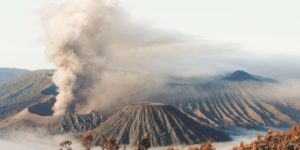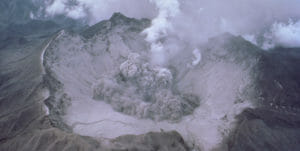Using Aerosols as Planetary ‘Sunscreen’ Would Be Huge Risk
Research indicates that if such a remedial action worked and then was stopped, global warming would resume at up to 10 times the speed. NASA is researching the effects of atmospheric aerosols. (Michael Starobin, NASA / Wikimedia Commons)
NASA is researching the effects of atmospheric aerosols. (Michael Starobin, NASA / Wikimedia Commons)
Geoengineering, spraying atmospheric aerosols as the technofix answer to a warming planet, has been repeatedly denounced as dangerous by many critics. Now scientists say it could hide another hazard: once started, it might be dangerous to stop.
That is because their research shows that if this planetary sunscreen worked, and the technology was then brought to a halt, global warming would resume, at up to 10 times the speed.
And that would present even more danger for plants and animals already at risk from climate change, according to US scientists who write in the journal Nature Ecology and Evolution.
“Rapid warming after stopping would be a huge threat to the natural environment and biodiversity,” said Alan Robock, a climate scientist at Rutgers University – New Brunswick.
“If geoengineering ever stopped abruptly, it would be devastating, so you would have to be sure that it could be stopped gradually, and it is easy to think of scenarios that would prevent that.
“Imagine large droughts or floods around the world that could be blamed on geoengineering, and demands that it stop. Can we ever risk that?”
Almost all climate scientists argue that the proper way to control climate change is to drastically cut fossil fuel use and switch to wind, solar and water power to drive modern economies.
Even proponents of the technofix – the use of expensive technologies to screen or reflect sunlight by, for instance, spraying sulphate aerosols into the stratosphere – concede that prevention is best.
The geoengineering argument remains on the table of possibilities because, for the moment, progress towards real reduction is slow, and researchers have repeatedly warned that hopes of containing global warming, and limiting climate change, are dwindling.
So, once again, Rutgers scientists looked at ways of darkening the upper skies, and their implications. Although researchers have warned again and again of the dangers of such steps, at least one study has conceded that, in theory, the technology could be made to work.
So Professor Robock and colleagues considered the sky-spray solution again. They modelled the injection by high-flying aircraft of five million tons of sulphur dioxide into the upper atmosphere, over the equator, from 2020 to 2070. This is the annual equivalent of about one quarter of the sulphate aerosols hurled into the upper atmosphere by the eruption of Mt Pinatubo, in 1991, in the Philippines.
The sulphate clouds would spread evenly over the northern and southern hemispheres, to lower global temperatures by about 1°C, and bring them back down to the global average before the Industrial Revolution. But any halt in the programme would bring global warming back much faster than if geoengineering had never been deployed.
The researchers then tried to calculate how plants and animals, all of which have adapted over the millennia to particular levels of rainfall and temperature, would respond. In many cases, the rate of warming would be four to seven times faster than the rate at which arthropods, birds, fish, mammals and reptiles could respond.
Climate change is already a threat to global biodiversity. Accelerated climate change after a period of containment would be even more dramatic.
“In many cases, you’d have to go one direction to find the same temperature but in a different direction to find the same precipitation. Plants, of course, can’t move reasonably at all. Some animals can move and some can’t,” said Professor Robock.
“We really need to look in a lot more detail at the impact on specific organisms and how they might adapt if geoengineering stops suddenly.”
Your support matters…Independent journalism is under threat and overshadowed by heavily funded mainstream media.
You can help level the playing field. Become a member.
Your tax-deductible contribution keeps us digging beneath the headlines to give you thought-provoking, investigative reporting and analysis that unearths what's really happening- without compromise.
Give today to support our courageous, independent journalists.





You need to be a supporter to comment.
There are currently no responses to this article.
Be the first to respond.